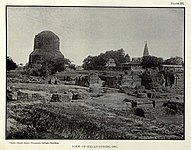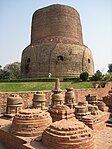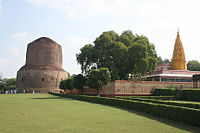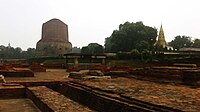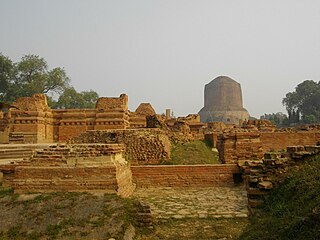
Sarnath is a town located 8 kilometres northeast of Varanasi, near the confluence of the Ganges and the Varuna rivers in Uttar Pradesh, India. According to the Lalitavistara sutra, the Gautama Buddha chose "Deer Park by the Hill of the Fallen Sages, outside of Varanasi" for the location of his first teachings of Buddhism, known as the Dhammacakkappavattana sutra, after he attained enlightenment at Bodh Gaya. It is one of eight most important pilgrimage sites for Buddhists, and has been nominated to become a UNESCO World Heritage Site.

Sanchi Stupa is a Buddhist complex, famous for its Great Stupa, on a hilltop at Sanchi Town in Raisen District of the State of Madhya Pradesh, India. It is located, about 23 kilometers from Raisen town, district headquarter and 46 kilometres (29 mi) north-east of Bhopal, capital of Madhya Pradesh.
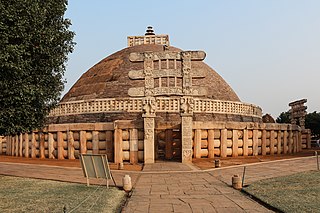
In Buddhism, a stupa is a mound-like or hemispherical structure containing relics that is used as a place of meditation.

The pillars of Ashoka are a series of monolithic columns dispersed throughout the Indian subcontinent, erected—or at least inscribed with edicts—by the 3rd Mauryan Emperor Ashoka the Great, who reigned from c. 268 to 232 BC. Ashoka used the expression Dhaṃma thaṃbhā, i.e. "pillars of the Dharma" to describe his own pillars. These pillars constitute important monuments of the architecture of India, most of them exhibiting the characteristic Mauryan polish. Twenty of the pillars erected by Ashoka still survive, including those with inscriptions of his edicts. Only a few with animal capitals survive of which seven complete specimens are known. Two pillars were relocated by Firuz Shah Tughlaq to Delhi. Several pillars were relocated later by Mughal Empire rulers, the animal capitals being removed. Averaging between 12 and 15 m in height, and weighing up to 50 tons each, the pillars were dragged, sometimes hundreds of miles, to where they were erected.

Shravasti ; Pali: 𑀲𑀸𑀯𑀢𑁆𑀣𑀻, romanized: Sāvatthī) is a town in Shravasti district in Indian state of Uttar Pradesh. It was the capital of the ancient Indian kingdom of Kosala and the place where the Buddha lived most after his enlightenment. It is near the Rapti river in the northeastern part of Uttar Pradesh India, close to the Nepalese border.

Assaji was one of the first five arahants of Gautama Buddha. He is known for his conversion of Sariputta and Mahamoggallana, the Buddha's two chief male disciples, counterparts to the nuns Khema and Uppalavanna, the chief female disciples. He lived in what is now Uttar Pradesh and Bihar in northern India, during the 6th century BCE.
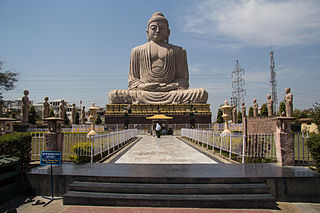
In religion and spirituality, a pilgrimage is a long journey or search of great moral significance. Sometimes, it is a journey to a sacred place or to a shrine of importance to a person's beliefs and faith. Members of every major religion participate in pilgrimages. A person who makes such a journey is called a pilgrim.
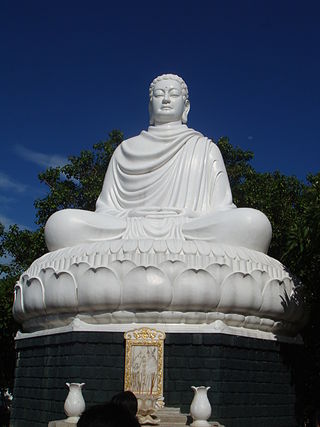
Thích Ca Phật Đài is a notable Theravada Buddhist temple in the coastal city of Vung Tau in southern Vietnam. It lies to the northwest of the Lớn mountain and was built between 1961 and 1963 when it was opened.

The Culture of Uttar Pradesh is an Indian culture which has its roots in Hindi, Bhojpuri and Urdu literature, music, fine arts, drama and cinema. Lucknow, the capital of Uttar Pradesh, has historical monuments including Bara Imambara and Chhota Imambara, and has preserved the damaged complex of the Oudh-period British Resident's quarters, which are being restored.

Situated in the northern part of India, bordering with the capital of India New Delhi, Uttar Pradesh is one of the most popular and an established tourist destination for both Indians and non-Indians alike in India. The most populous state of India, Uttar Pradesh contains many historical monuments and places of religious significance. Geographically, Uttar Pradesh is very diverse, with Himalayan foothills in the extreme north and the Gangetic Plain in the centre. It is also home of India's most visited sites, Hinduism's holiest city, Varanasi. Kumbh city, Prayagraj. Kathak, one of the eight forms of Indian classical dances, originated from Uttar Pradesh. Uttar Pradesh is at the heart of India, hence it is also known as The Heartland of India. Cuisine of Uttar Pradesh like Awadhi cuisine, Mughlai cuisine and Bhojpuri cuisine are very famous not only in India but also many places abroad.

Kesariya stupa is a Buddhist stupa in Kesariya, located at a distance of 110 kilometres (68 mi) from Patna, in the East Champaran district of Bihar, India. Construction of the stupa at this site began in the 3rd century BCE. Kesariya Stupa has a circumference of almost 400 feet (120 m) and a height of about 104 feet (32 m).

The Lion Capital of Ashoka is the capital, or head, of a column erected by the Mauryan emperor Ashoka in Sarnath, India, c. 250 BCE. Its crowning features are four life-sized lions set back to back on a drum-shaped abacus. The side of the abacus is adorned with wheels in relief, and interspersing them, four animals, a lion, an elephant, a bull, and a galloping horse follow each other from right to left. A bell-shaped lotus forms the lowest member of the capital, and the whole 2.1 metres (7 ft) tall, carved out of a single block of sandstone and highly polished, was secured to its monolithic column by a metal dowel. Erected after Ashoka's conversion to Buddhism, it commemorated the site of Gautama Buddha's first sermon some two centuries before.

Kushinagar is a town in the Kushinagar district in Uttar Pradesh, India. Located 53 kilometres east of Gorakhpur on National Highway 27, Kushinagar is an important and popular Buddhist pilgrimage site, where Buddhists believe Gautama Buddha died and attained parinirvana.
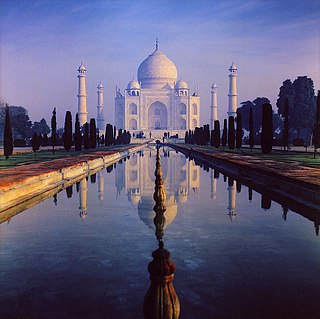
The architecture of Uttar Pradesh demonstrates a diverse and eclectic combination of Buddhist, Hindu, Indo-Islamic, and Indo-European architectural styles. Three of its architectural monuments—the Taj Mahal, the Agra Fort, as well as the township of Fatehpur Sikri founded by the Mughal emperor Akbar—are designated UNESCO World Heritage Sites. The architectural structures in Uttar Pradesh include ancient Buddhist stūpas and vihāras, ancient Buddhist and Hindu monasteries, townships, forts, palaces, temples, mosques, mausoleums, memorials, and other community structures. Uttar Pradesh's architectural structures also include various Hindu temples, Ghats, etc. largely found in ancient cities like Benares (Varanasi), Brindaban (Vrindavan), Mathura, and Prayagraj (Allahabad).
Varanasi, also known as Kashi, is considered as the religious capital of Hinduism. In the Hindu faith, it is the holiest of all of its cities; the four dhams in the four cardinal directions of the country – Badrinath in the north, Puri in the east, Dwarka in the west and Rameshwaram in the south – are all represented in the city in "archetypal forms" as the presiding deities at Badrinath Ghat, Assi's Jagannath Temple area, Shankudhara Pokhra, and Mir Ghat respectively. Other Hindu holy places, such as the Kedarnath at Kedar Ghat, Mathura at Bakaruia Kund or Nakhi Ghat, Prayagraj (Allahadbad) at Dashahvamedha Ghat, Kamakhya (Assam) at Kamachha, Kurukshetra at Kurkukshetra Kund near Asi, and Lake Manasarovar at Mansarovar near Shyameshvara are a part of the city's religious and cultural heritage.

Sonari is the archaeological site of an ancient monastic complex of Buddhist stupas. The site, positioned on a hill, is located about 10 km southwest of Sanchi, Madhya Pradesh, India. near Salamatpur Railway Station.

Ancient Indian architecture ranges from the Indian Bronze Age to around 800 CE. By this endpoint Buddhism in India had greatly declined, and Hinduism was predominant, and religious and secular building styles had taken on forms, with great regional variation, which they largely retain even after some forceful changes brought about by the arrival of first Islam, and then Europeans.

The Buddha Preaching his First Sermon is a stone sculpture of the 5th-century CE showing Gautama Buddha in the "teaching posture" or dharmachakra pravartana mudrā. The relief is 5' 3" tall, and was excavated at Sarnath, India by F. O. Oertel during the 1904–1905 excavation season of the Archaeological Survey of India (ASI); it was found in an area to the south of the Dhamek Stupa.

Sarnath Jain Tirth, also called the Shreyanshnath Jain Pilgrimage, is a group of Jain temples in Sarnath. They are located near Dhamek Stupa.

Giriyak Stupa, also known as Jarasandha-ka-baithak, is an ancient cylindrical stupa located in the Nalanda district of Bihar, India.





